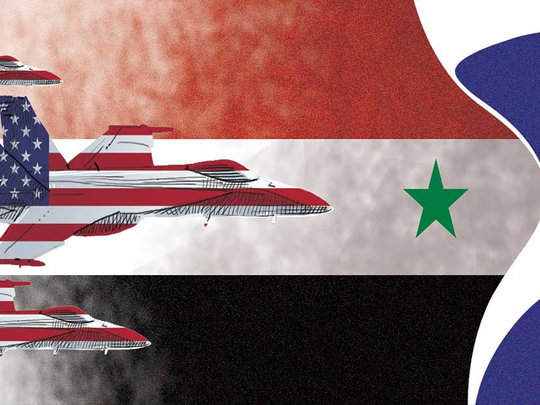
It’s time to stop this constant refrain that United States President Barack Obama has no strategy for Syria.
There is and always has been a strategy. From 2011 it has been to end the regime of Syrian President Bashar Al Assad, primarily through diplomatic rather than military means. Since 2012, the Obama strategy has been to use force to degrade and defeat Daesh (the self-proclaimed Islamic State of Iraq and the Levant).
The basic element of the diplomatic strategy for ending Al Assad’s rule, repeated in last Friday’s Vienna communique, says: “This political process will be Syrian-led and Syrian-owned, and the Syrian people will decide the future of Syria.”
Defeating Daesh in Syria, under Obama’s strategy, rests on enabling local Syrian forces not only to beat back Daesh fighters, but to hold freed territory until a new central government, established in Damascus, can take over.
Given Syria’s history, no outside country — particularly the US — can end a civil war with so many different tribes, ethnic groups and religious elements fighting to gain power and settle old debts.
There is no quick fix to Syria’s problems. A solution could and probably will take many years, lasting well beyond the end of the Obama administration.
The diplomatic side has at least two major roadblocks. The first is basic: Who will represent the Syrian opposition if and when a planned meeting under United Nations auspices takes place? The meeting would be held to determine an interim Damascus government and the process for a new constitution and elections.
The UN Special Envoy for Syria, Staffan de Mistura, said at the Vienna news conference after a meeting of major powers that he has been dealing with about 230 Syrian entities and groups plus the government. At the last such meeting in 2014 in Geneva, the opposition appeared as the Syrian Opposition Coalition, but there is no such united group.
There is also the serious disagreement between the US and Russia over which of Al Assad’s opponents is a terrorist organisation, because the Syrian president has called all of them terrorists.
Last Friday’s agreement says Daesh “and other terrorist groups, as designated by the UN Security Council, and further, as agreed by the participants, must be defeated”. If any ceasefire is agreed upon, it would not prevent attacks against such groups. Russian Foreign Minister Sergei Lavrov made it clear that he wants to add some groups to the terrorist list, probably some that the US supports.
The military side is no less complicated.
What changed last week was not Obama’s Syria strategy, but some US tactics — because they were not working.
“If you don’t adapt the way you execute and implement your strategy, then ... unless you can see the future with perfect clarity, you’re setting yourself up for failure,” said US State Department spokesman John Kirby, a retired admiral who served previously as spokesman for the Defence Department. In this case, Kirby said, creating capable indigenous Syrian forces in camps outside Syria was more difficult than expected.
A senior US Defence Department official told reporters that a lesson from the Iraq experience was that US forces alone could very quickly clear areas, such as those held by Daesh fighters in Syria. “But we need [local] forces on the ground that will hold and build, or else we [Americans] will be there for a significant chunk of time.”
The new approach calls for fewer than 50 Special Operations members in teams to be sent in the next month from the US to northern Syria to support selected Syrian Kurdish, Turkmen and Syrian Arab forces fighting in the area. The US teams will work for weeks and perhaps months at what serves as headquarters for one or more of these groups to coordinate their tactics, operational planning and logistics.
The purpose is to determine what further military cooperation can develop. “We need to get on the ground, meet them,” the Pentagon official said. “There’s nothing quite like the face-to-face contact.” The official added, “Until we have greater faith, then I don’t think we’re anticipating our forces going and accompanying the [Syrian-based insurgent] forces on the ground”.
For the foreseeable future, the new US personnel will not do joint operations with those Syrian groups, nor serve as forward air controllers to guide US and coalition aircraft to targets. They are there “to work with the units that are there fighting [Daesh] and see what more is possible,” the Pentagon official said.
In other words, the door remains open for sending more American troops into Syria, depending what happens in the next few months. There are Special Forces units in the region that have carried out unilateral raids into Syria, such as the one last May by the Army’s Delta Force that killed Abu Sayyaf, a senior Daesh leader. Such raids will continue, the official said.
Obama has also decided to boost tactical aircraft available for the fight, putting in 12 A-10s that are useful to give support to fighters on the ground when the enemy has no aircraft and elementary air defences. Another dozen more F-15 fighter bombers also are on their way. These will increase air operations in northern Syria, particularly in the Turkish border area, to cut the flow of foreign fighters, money and material into supporting Daesh. This step is not to be considered “the start of a no-fly zone or a creeping no-fly zone. That’s just not the intent”, the Pentagon official said.
You cannot ignore that the US is on a slope in Syria. The Obama administration, for the next 15 months, must figure out just how slippery it may be.
— Washington Post









